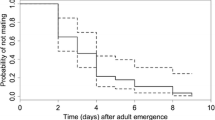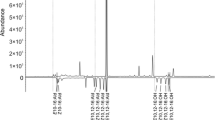Abstract
Finding mates is frequently problematic for parasitoid wasps. In some parasitoid species, males rely on volatile, airborne sex pheromones for locating mates, while in others they rely on contact, trail sex pheromones. This study sought to shed light on the mate finding mechanism of males of Aphytis melinus. Specifically, the goal was to determine whether A. melinus males use airborne or contact pheromones, or both, for locating mates. The study showed that A. melinus males rely on a contact, trail sex pheromone for locating mates: A. melinus males responded to substrate-borne cues left by virgin females, while they did not respond to airborne cues from virgin females. Specifically, males more frequently encountered virgin females when the females walked across an arena to a fixed encounter point compared to when they were manually placed at the encounter point, and spent greater than expected time on surfaces previously visited by virgin females compared to control surfaces not visited by females. In contrast, males did not respond to airborne cues from virgin females in an airflow olfactometer nor to traps baited with virgin females in the field, and spent similar lengths of time on surfaces visited by newly-mated or 24-h mated females versus control surfaces not visited by females. The main effect of the trail sex pheromone on the behavior of A. melinus males was to direct their search and, so, increase the likelihood of encountering mates. This effect apparently is not preceded by longer-range attraction of males via an airborne female sex pheromone. Overall, the results of this study support a hypothesis in which A. melinus males searching on substrates on which females may be present rely exclusively on a trail sex pheromone to locate mates.



Similar content being viewed by others
References
Alcock J (1981) Notes on the reproductive behavior of some Australian thynnine wasps (Hymenoptera: Tiphiidae). J Kans Entomol Soc 54:681–693
Allen GR, Kazmer DJ, Luck RF (1994) Post-copulatory male behaviour, sperm precedence and multiple mating in a solitary parasitoid wasp. Anim Behav 48:635–644
Bellamy DE, Byrne DN (2001) Effects of gender and mating status on self-directed dispersal by the whitefly parasitoid Eretmocerus eremicus. Ecol Entomol 26:571–577
Blum MS (1974) Pheromonal sociality in Hymenoptera. In: Birch MC (ed) Pheromones. North Holland Publication, Amsterdam, pp 222–249
DeBach P, White EB (1960) Commercial mass culture of the California red scale parasite Aphytis lignanensis. Calif Agric Expt Stat Bull 770
DeLury NC, Gries G, Gries R, Judd GJR, Brown JJ (1999) Sex pheromone of Ascogaster quadridentata, a parasitoid of Cydia pomonella. J Chem Ecol 25:2229–2245
Eller FJ, Bartlet RJ, Jones RL, Kulman HM (1984) Ethyl (Z)-9-hexadecenoate a sex pheromone of Syndipnus rubiginosus, a sawfly parasitoid. J Chem Ecol 10:291–300
Fauvergue X, Hopper KH, Antolin MF (1995) Mate finding via a trail sex pheromone by a parasitoid wasp. Proc Natl Acad Sci U S A 92:900–904
Godfray HCJ (1994) Parasitoids: behavioral and evolutionary ecology. Princeton University Press, Princeton
Gordh G, DeBach P (1978) Courtship behavior in the Aphytis lingnanensis group, its potential usefulness in taxonomy, and a review of sexual behavior in the parasitic Hymenoptera (Chalc.: Aphelinidae). Hilgardia 46:37–75
Gregory WA (1985) In-flight response of citrus-inhabiting Aphelinidae (Hymenoptera) to trap colors and plant structure. Ph.D. dissertation, University of California, Riverside
Hardy ICW, Godfray HCJ (1990) Estimating the frequency of constrained sex allocation in field populations of Hymenoptera. Behaviour 114:137–147
Heimpel GE, Rosenheim JA, Kattari D (1997) Adult feeding and lifetime reproductive success in the parasitoid Aphytis melinus. Entomol Exp Appl 83:305–315
Hopper KR, Roush RT (1993) Mate finding, dispersal, number released, and the success of biological control introductions. Ecol Entomol 18:321–331
Jacob S, Boivin G (2005) Costs and benefits of polyandry in the egg parasitoid Trichogramma evanescens Westwood (Hymenoptera: Trichogrammatidae). Biol Control 32:311–318
Jewett DK, Carpenter JE (1999) Chemically-mediated attraction of Ichneumon (= Pterocormus) promissorius (Hymenoptera: Ichneumonidae) males by females. Environ Entomol 28:551–556
Kainoh Y, Oishi Y (1993) Source of a sex pheromone of the egg-larval parasitoid, Ascogaster reticulatus Watanabe (Hymenoptera: Braconidae). J Chem Ecol 19:963–969
Kamano Y, Shimizu K, Kainoh Y, Tatsuki S (1989) Mating behavior of Ascogaster reticulatus Watanabe (Hymenoptera: Braconidae), an egg-larval parasitoid of the smaller tea tortrix, Adoxophyes sp. (Lepidoptera: Tortricidae). II. Behavioral sequence and a role of sex pheromone. Appl Entomol Zool 24:372–378
Kazmer DJ, Luck RF (1995) Field tests of the size-fitness hypothesis in the egg parasitoid Trichogramma pretiosum. Ecology 76:412–425
King BH, Saporito KB, Ellison JH, Bratzke RM (2005) Unattractiveness of mated females to males in the parasitoid wasp Spalangia endius. Behav Ecol Sociobiol 57:350–356
Lewis WJ, Snow JW, Jones RL (1971) A pheromone trap for studying populations of Cardiochiles nigriceps, a parasite of Heliothis virescens. J Econ Entomol 64:1417–1421
Luck RF, Podoler H, Kfir R (1982) Host selection and egg allocation behaviour by A. melinus and A. lingnanensis: comparison of two facultatively gregarious parasitoids. Ecol Entomol 7:397–408
McAuslane HJ, Vinson SB, Williams HJ (1990) Influence of host plant on mate location by the parasitoid Campoletis sonorensis (Hymenoptera: Ichneumonidae). Environ Entomol 19:26–31
Mohamed MA, Coppel HC (1987) Pheromonal basis of courtship behavior in two gypsy moth parasitoids: Brachymeria intermedia (Nees) and Brachymeria lasus (Walker) (Hymenoptera: Chalcididae). J Chem Ecol 13:1099–1113
Morgan DJW, Hare JD (1998) Volatile cues used by the parasitoid, Aphytis melinus, for host location: California red scale revisited. Entomol Exp Appl 88:235–245
Opp SB, Luck RF (1986) Effects of host size on selected fitness components of A. melinus and A. lingnanensis (Hymenoptera: Aphelinidae). Ann Entomol Soc Am 79:700–704
Pompanon F, De Schepper B, Mourer Y, Fouillet P, Bouletreau M (1998) Evidence for a substrate-borne sex pheromone in the parasitoid wasp Trichogramma brassicae. J Chem Ecol 23:1349–1360
Quicke DLJ (1997) Parasitic wasps. Chapman & Hall, London
Rao SV, DeBach P (1969) Experimental studies on hybridization and sexual isolation between some Aphytis species (Hymenoptera: Aphelinidae). II. Experimental hybridization and an interpretation of evolutionary relationships among the species. Hilgardia 39:515–553
Robacker DC, Weaver KM, Hendry LB (1976) Sexual communication and associative learning in the parasitic wasp Itoplectis conquisitor. J Chem Ecol 2:39–48
Rosen D, DeBach P (1979) Species of Aphytis of the world (Hymenoptera: Aphelinidae). Dr. J. W. Junk, The Hague
Ruther J, Homann M, Steidle, JLM (2000) Female-derived sex pheromone mediates courtship behaviour in the parasitoid Lariophagus distinguendus. Entomol Exp Appl 96(3):265–274
Sternlicht M (1973) Parasitic wasps attracted by the sex pheromone of their coccid host. Entomophaga 18:339–342
Tagawa J (1977) Localization and histology of the female sex pheromone-producing gland in the parasitic wasp, Apanteles glomeratus. J Insect Physiol 23:49–56
Tashiro H (1966) Improved laboratory techniques for California red scale on lemons. J Econ Entomol 59:604–608
Vet LEM, van Lenteren JC, Heymans M, Meelis E (1983) An airflow olfactometer for measuring olfactory responses of hymenopterous parasitoids and other small insects. Physiol Entomol 8:97–106
Vinson SB (1998) The general host selection behavior of parasitoid Hymenoptera and a comparison of initial strategies utilized by larvaphagous and oophagous species. Biol Control 11:79–96
Zar JH (1996) Biostatistical analysis. Prentice Hall, Upper Saddle River, USA
Acknowledgements
This research was supported in part by USDA-NRI grant Size-fitness relationships in a parasitoid wasp and implications for augmentative biological control to JSB. Lisa Forster (University of California, Riverside) provided advice, technical support, and insects. The suggestions of Dr. Brad Vinson, Refugio Lomelí-Flores, and Andrea Joyce (all at Texas A&M University), and of two anonymous reviewers greatly improved the manuscript.
Author information
Authors and Affiliations
Corresponding author
Rights and permissions
About this article
Cite this article
Bernal, J.S., Luck, R.F. Mate Finding Via a Trail Sex Pheromone by Aphytis melinus DeBach (Hymenoptera: Aphelinidae) Males. J Insect Behav 20, 515–525 (2007). https://doi.org/10.1007/s10905-007-9092-1
Revised:
Accepted:
Published:
Issue Date:
DOI: https://doi.org/10.1007/s10905-007-9092-1




